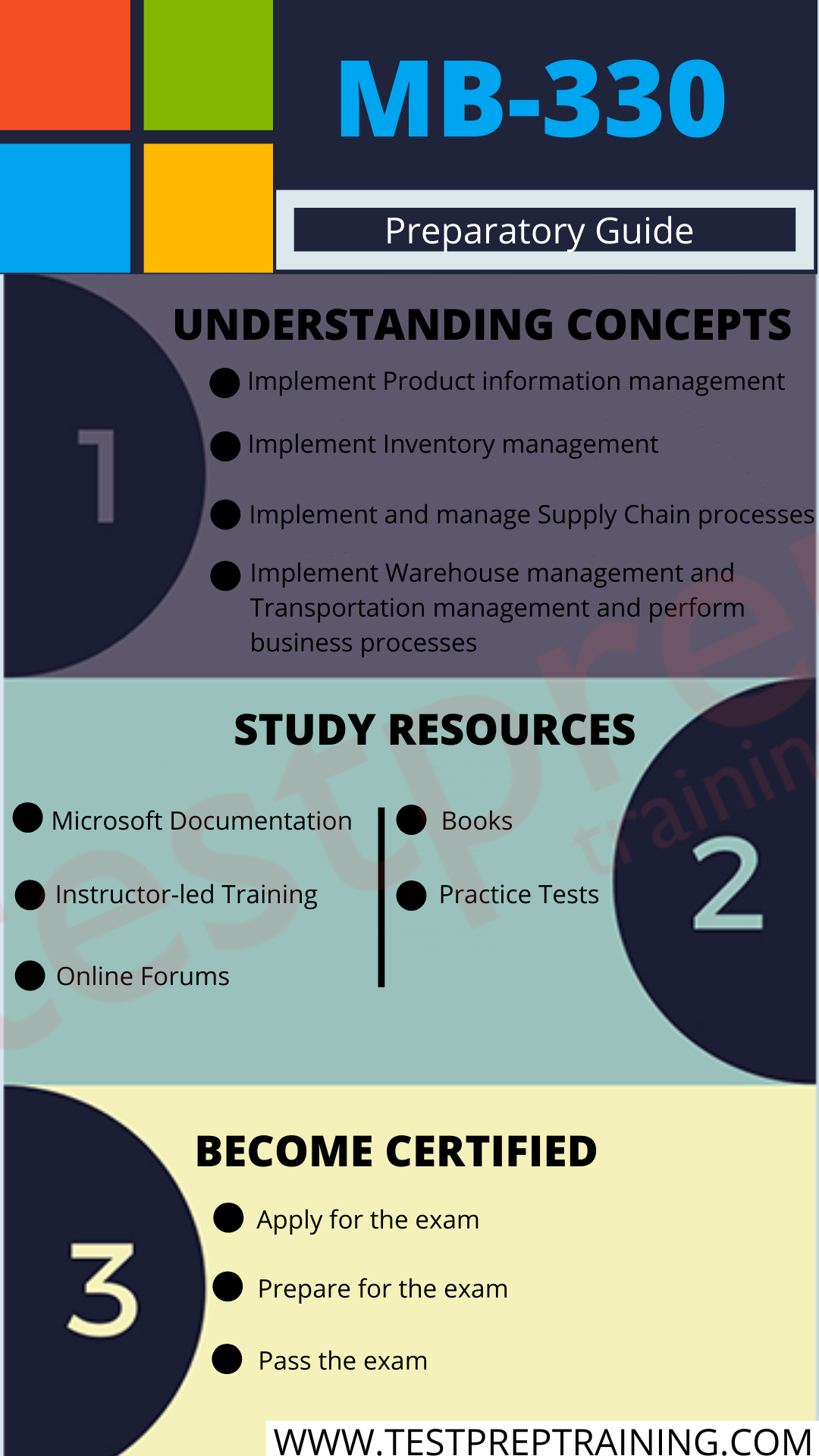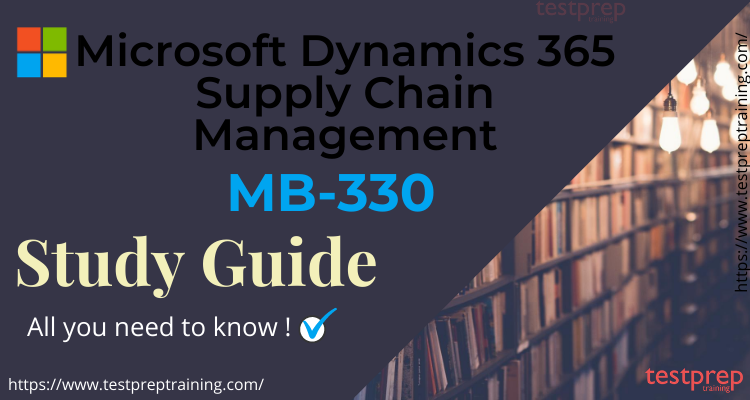Want to become a Microsoft Certified Supply Chain Management Functional Consultant Associate? Looking for a Guide to provide direction to your preparations? Look no further, as we provide you the information goldmine! This study guide highlights all the necessary learning resources to crack the MB-330 exam. Further taking this certification exam will expose you to explore real-world mastery. This certification will give you a professional edge over your peers and enhance your employability. When getting ready for a certification or exam, it’s crucial for a candidate to know where to start. So, let’s begin by examining the exam details.
MB-330: Microsoft Dynamics 365 Supply Chain Management exam validates the candidate’s knowledge of analyzing business requirements and translate those requirements into fully-realised business processes and solutions that implement industry best practices. Candidates after passing the exam serve as a key resource in implementing and configuring applications to meet business requirements.
Recommended Knowledge : MB-330
The prerequisites for Microsoft Certification MB 330 are:
- To begin with, Familiarity with accounting principles and financial operations of businesses, customer service, field service, manufacturing, retail, and supply chain management concepts.
- Then, Specialization in one or more feature sets of Microsoft Dynamics 365 Finance, including finance, manufacturing, and supply chain management.
- Also, Knowledge of supply chain management practices, such as procurement, trade, logistics, warehouse management, and transportation management.
Microsoft MB-330 Study Guide
Proper preparation is the path to success. This study guide is made to assist you in getting ready for the exams. It will guide you through all the study materials and give you clear steps to prepare for the exam. Let’s talk about it.

Step 1- Always Start with the MB-330 Exam Objectives
The first thing you should do when preparing is to visit the Official Guide and go over the exam objectives carefully. A closer look at each area of the Microsoft MB-330 exam can give you a better idea of what the exam aims to test. Plus, the course provides a foundation for all Microsoft MB-330 Exam Questions. When preparing, it’s important to focus your study plan on the exam concepts. This exam covers the following MB 330 Exam Topics:
Domain 1: Implement product information management (20-25%)
Create and manage products
- create and release products and product variants (Microsoft Documentation: Create products )
- create and apply product templates (Microsoft Documentation: Product templates)
- Create bills of materials (BOMs) and BOM versions
- create and configure category hierarchies (Microsoft Documentation: Create and configure category hierarchies and attributes)
- Create and manage product states during the life cycle of a product (Microsoft Documentation: Product lifecycle state overview)
- Create product attributes (Microsoft Documentation: Manage attributes and attribute groups)
- Assign variant-specific item sales tax groups for product variants
Configure prerequisites for products
- Configure inventory dimensions, including storage, tracking, and product dimension groups (Microsoft Documentation: About inventory dimensions and dimension groups)
- Create item model groups
- Configure reservation hierarchies (Microsoft Documentation: Set up reservation hierarchies)
- Configure unit sequence groups
Configure additional product details
- Create and assign bar codes and Global Trade Item Number (GTIN) codes (Microsoft Documentation: GS1 bar codes)
- Configure product unit conversions (Microsoft Documentation: Set up units and unit conversions (Retail essentials))
- Configure default order settings (Microsoft Documentation: Default order settings for dimensions and product variants)
- Configure product filter codes for warehouse operations
Manage inventory pricing and costing
- Configure and maintain costing versions for standard and planned costs (Microsoft Documentation: Costing versions overview)
- Configure price groups
- Configure items with standard costs (Microsoft Documentation: Prerequisites for standard costs overview)
- Configure default item prices, purchase and sales prices, and discounts in trade agreements Create a new trade agreement)
Domain 2: Implement inventory and asset management (25–30%)
Configure Inventory management
- Create and manage inventory dimensions
- Configure inventory reports
- Configure ABC classifications (Microsoft Documentation: ABC inventory classification )
- Configure the cost basis type and pricing template for commodity pricing
Manage and process inventory activities
- Create and process journals, including BOMs, item arrival, output order, transfer, movement, inventory adjustment, and counting journals (Microsoft Documentation: Inventory journals )
- create and process transfer orders (Microsoft Documentation: Create and process transfer orders from the warehouse app )
- Describe the inventory closing and adjustment process
- Configure and perform inventory closings and adjustments (Microsoft Documentation: Inventory close )
- Apply inventory blocking manually (Microsoft Documentation: Inventory blocking )
- Create batch disposition codes
Manage quality
- Configure and process nonconformances (Microsoft Documentation: Create and process nonconformances)
- Configure quality associations (Microsoft Documentation: Quality associations)
- Configure components for the quality control process
- Process quality orders (Microsoft Documentation: Quality orders)
- Process quarantine orders (Microsoft Documentation: Quarantine orders)
- Configure inventory blocking by using a quality order (Microsoft Documentation: Inventory blocking)
Configure asset management
- Create and manage work orders (Microsoft Documentation: Manually created work orders)
- Create and configure assets (Microsoft Documentation: Create an asset)
- View and manage capacity for work orders
- Configure work order settings
- Schedule preventive maintenance and reactive maintenance (Microsoft Documentation: Schedule maintenance plans)
- Manage and configure asset loans (Microsoft Documentation: Asset loans)
Implement asset management
- Configure maintenance plans
- Configure functional locations (Microsoft Documentation: Create functional locations)
- Manage maintenance requests (Microsoft Documentation: Maintenance requests)
- Manage work orders consumption (Microsoft Documentation: Introduction to work orders)
- Manage work order scheduling
Domain 3: Implement and manage supply chain processes (15–20%)
Implement Procurement and sourcing
- Create and maintain vendors
- create and manage purchase requisitions, requests for quotes (RFQs), and purchase orders (POs) (Microsoft Documentation: Creating purchase requisitions )
- Create purchase agreements and vendor rebates
- Configure and process consignment inventory (Microsoft Documentation: Inventory management overview )
- manage over and under deliveries and delivery schedules (Microsoft Documentation: Delivery schedules )
- Configure procurement categories, charge codes, and purchasing policies (Microsoft Documentation: Purchasing policies overview)
- Configure vendor collaboration features
- Create and process vendor returns (Microsoft Documentation: Process sales return orders)
- Manage registration and product receipt
- Configure procurement workflows (Microsoft Documentation: Set up Procurement and sourcing workflows)
Implement landed cost
- Configure landed cost parameters and voyage statuses (Microsoft Documentation: Landed cost parameters setup)
- Create and process voyage with purchase orders or transfer orders
- Configure cost estimations, tracking control center, over/under tolerance setup, and journey templates (Microsoft Documentation: Work breakdown structures overview)
- Configure cost type codes and auto-costs
Implement common sales and marketing features
- Create and maintain customers
- Configure sales agreements
- Configure and process sales quotations, sales orders, and sales returns (Microsoft Documentation: Create a sales quotation)
- configure sales groups, commissions (Microsoft Documentation: Configure and use commissions )
- Configure and process intercompany orders
- Configure customer rebates
- Configure and manage delivery schedule, available-to-promise (ATP), and capable-to-promise (CTP)
Domain 4: Implement warehouse management and transportation management (15–20%)
Configure warehouse management
- create sites, warehouses, locations, location formats, location profiles, location types, and zones (Microsoft Documentation: Warehouse management overview )
- Create and manage warehouse workers
- Configure work policies and work breaks
- implement location directives (Microsoft Documentation: Location directives )
- Configure wave, load, and work templates
- configure mobile device menus, menu items, and display settings (Microsoft Documentation: Configure mobile device setup)
- Create and print labels, including product, wave, GS1 label segments, and license plate labels
- Configure packing dimensions
Perform warehouse management processes
- Configure and process replenishment
- Manage load planning workbench
- Configure and process inventory movements for advanced warehousing
- Create cycle counting work and perform cycle counting (Microsoft Documentation: Cycle counting )
- Process inbound and outbound orders (Microsoft Documentation: Inbound operations, Outbound operations)
- Configure containerization and packaging options
- Configure and process cross docking
Implement transportation management
- configure shipping carriers and carrier groups
- perform planning and executing of loads and shipments (Microsoft Documentation: Plan loads and shipments using the Load planning workbench )
- configure and generate freight bills and invoices (Microsoft Documentation: Plan freight transportation routes with multiple stops )
- configure rout plans and guides (Microsoft Documentation: Transportation management engines )
- configure route and rate engines (Microsoft Documentation: Transportation management engines)
- configure and use dock appointment scheduling (Microsoft Documentation: Set up an appointment for a load )
- Reconcile freight by using manual or automatic processes
Domain 5: Implement master planning (10–15%)
Configure master planning
- Set up coverage groups and item coverage (Microsoft Documentation: Coverage settings )
- configure and maintain master planning parameters and master plan (Microsoft Documentation: Master plans overview )
- Define positive and negative days
- Define action messages, delay messages, and time fences (Microsoft Documentation: Master plans overview)
- configure period templates (Microsoft Documentation: Create working time templates)
Manage master plans
- Run master planning and analyze the results (Microsoft Documentation: Master planning system architecture)
- Evaluate and process planned purchase and transfer orders (Microsoft Documentation: Master planning with purchase trade agreements)
- Set up and use the Supply Schedule form (Microsoft Documentation: Supply schedule)
- Configure safety margins
- Configure and process safety stock journals
Step 2- Know your Study Resources
The next thing to do is to find out about the learning materials you can use. Your choice of materials will affect how well you get ready and pass the exam. So, it’s important to be selective when picking your study resources. In this section, we’ll point out some study materials you can choose from.
Learning Resource 1: Microsoft Documentation
Microsoft provides documentation that includes various learning materials. Using Microsoft documentation can help you grasp the fundamentals of Microsoft Dynamics 365 Supply Chain Management. This documentation explains various aspects of different Azure services in great detail. This ensures that you’re up to date and learning about Azure technologies offered by industry experts directly from the source.
Learning Resource 2: Go for Instructor Led Training
Microsoft provides you with both online as well as instructor-led training. These instructor-led training courses are basically on-demand classroom sessions that you can easily arrange anywhere and anytime according to your convenience. These training sessions help you gain an upper hand in the MB-330 exam. So as you are able to find a Microsoft training partner, now you just have to head towards their website for booking training sections.
Learning Resource 3: Join Online Forums
Deciding to join a study group or forum is a personal choice, meaning it’s not required but it’s an option. If you’re preparing for the MB-330 exam, you can consider joining study groups and forums to increase your confidence. Online forums are great because they link you with others who are on the same learning path as you. You can ask questions if you’re struggling with a topic or offer help to fellow candidates. These discussions make your studies more complete. Additionally, forums are excellent for creating a community that’s important for understanding others.
Learning Resource 4: Learn from Books and Periodicals
Books are your oldest yet the most efficient medium to study from. They help you acquire knowledge in a clear and detailed manner which helps you understand the basics of the exam topics. Generally, books are required by candidates who want to build a strong base as well as familiarity with the exam concepts. The market is flooded with books and periodicals which you can refer to the study for the exam. So, make sure you find the most authentic and relevant one for you.
Step 3- Practice Tests
Once you’ve finished preparing, it’s time for the performance phase. This self-evaluation step helps you discover what you’re really good at and where you need improvement. Keep in mind that you should only start taking practice tests after you’ve covered the entire syllabus. Practice tests are made to mimic the real exam experience. Also, it’s important to train your mind for this. Start Practising now with Microsoft MB-330 Practice Tests !



